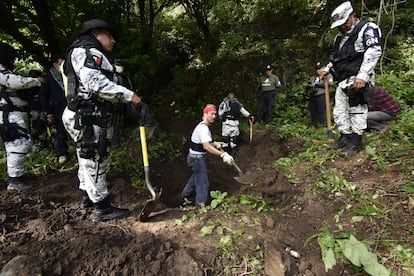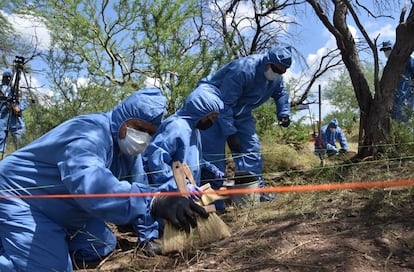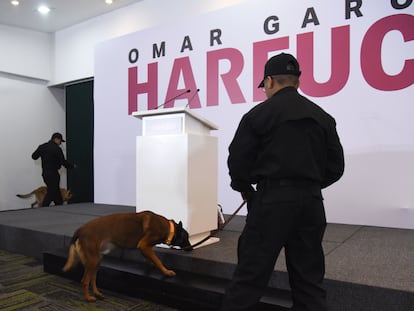Mapping Mexico’s 5,698 clandestine graves
The list of burials illuminates one of the favorite tactics of criminals in these times of war against drug trafficking and organized crime: ‘disappearing’ people

From January 2007 to April 2023, Mexican authorities reported the discovery of 5,698 clandestine graves throughout the country. It is a dizzying number, but just part of the figures that outline the violence that the country is experiencing: more than 110,000 missing people and 30,000 murders a year, in a bloodletting that seems to have no end. The map of the unmarked graves illuminates one of the favorite tactics of criminals in these times of war against drug trafficking and organized crime: “disappearing” people, concealing their death and their fate. The practice completely sidesteps an already decadent justice system handling soaring numbers of crimes that go unpunished.
In an investigation published on Monday, the non-profit investigative reporting organization Quinto Elemento Lab shows the evolution of the data, which are part of the records that the National Search Commission, dependent on the Ministry of the Interior, has accumulated over the years. The Mexican government runs a website that offers a map of the graves. But Quinto Elemento Lab has obtained the raw data from state prosecutors through transparency requests, to confirm the government’s statistics and organize the data according to criteria of geography and time.
The records show that the Mexican states with the most graves on their territory are Veracruz, Tamaulipas and Guerrero. In fact, between the three of them, they account for more than half of the finds in the entire country. Veracruz leads the list with 668 clandestine burials. In 2016, for example, authorities certified the location of 161 in that state alone. In 2019, there were 142. Tamaulipas follows Veracruz with 554, distributed more or less evenly between 2011 and 2022. Guerrero follows with 498. The year The worst year for Guerrero was 2014, during the search for the 43 missing student-teachers from the Ayotzinapa Rural Normal School.

There isn’t a huge gap between the top three states and the next on the list. The states of Sinaloa and Chihuahua surpassed the barrier of 400 graves each, while Colima and Zacatecas remain close. In total, 18 out of the 32 states in the country located 100 clandestine graves or more in their territory. At least one grave has been found in 570 municipalities, that is, in one of every four towns in Mexico.
Comparing the work of Quinto Elemento Lab with the executive’s own map, it is easy to see the government’s attempt to separate its records from those of previous governments. Thus, Mexico found 2,835 unmarked graves from January 2007 to December 2018, a range that includes the administrations of Felipe Calderón (2006-2012) and Enrique Peña Nieto (2012-2018). In the four and a half years of Andrés Manuel López Obrador’s term in office, the figure is 2,863.
Sign up for our weekly newsletter to get more English-language news coverage from EL PAÍS USA Edition
Tu suscripción se está usando en otro dispositivo
¿Quieres añadir otro usuario a tu suscripción?
Si continúas leyendo en este dispositivo, no se podrá leer en el otro.
FlechaTu suscripción se está usando en otro dispositivo y solo puedes acceder a EL PAÍS desde un dispositivo a la vez.
Si quieres compartir tu cuenta, cambia tu suscripción a la modalidad Premium, así podrás añadir otro usuario. Cada uno accederá con su propia cuenta de email, lo que os permitirá personalizar vuestra experiencia en EL PAÍS.
¿Tienes una suscripción de empresa? Accede aquí para contratar más cuentas.
En el caso de no saber quién está usando tu cuenta, te recomendamos cambiar tu contraseña aquí.
Si decides continuar compartiendo tu cuenta, este mensaje se mostrará en tu dispositivo y en el de la otra persona que está usando tu cuenta de forma indefinida, afectando a tu experiencia de lectura. Puedes consultar aquí los términos y condiciones de la suscripción digital.











































